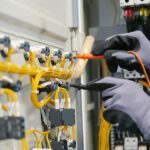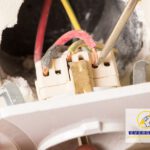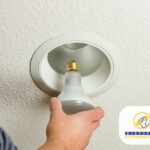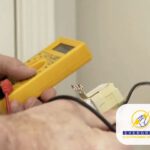Are you fed up of your electronics being at risk from power surges? Don’t let your valuable equipment become a victim of unpredictable electrical spikes. It’s time to take control and defend your devices with the right surge protector.
Just like a knight in shining armour, a surge protector can shield your electronics from the dangers of power surges. But with so many options available in the UK market, how do you select the perfect one for your needs?
From our opinion as a reliable electrical company, in this article, we’ll guide you through the process of choosing the ideal surge protector. We’ll explore considerations such as your power needs, surge protection requirements, joule rating, clamping voltage, key features, and outlet types.
By the end, you’ll have the knowledge to make an informed decision and provide your devices with the innovative protection they deserve.
Understand Your Power Needs
You’ll want to really delve into your power needs to make sure you’re getting the surge protector that’s going to keep your devices safe and sound. To work out your power consumption, evaluate your home’s electrical system.
Begin by identifying the devices that will be connected to the surge protector. Make a list and note their power ratings. This info can usually be found on the device’s label or in the user manual. Add up the wattage of all the devices to calculate the total power consumption.
Plus, think about any future devices you might add to the system. Being aware of your power needs will help you choose a surge protector with the suitable capacity.
With this understanding, you can now move on to determining your surge protection requirements and finding the right surge protector for your needs.
Determine Your Surge Protection Requirements
To ensure the safety of your electronics, it’s essential to work out the level of surge protection required for maximum efficiency. Here’s a guide to help you make an educated decision:
- Identify the total wattage: Estimate the power consumption of all the devices you want to protect. Add up their wattage to find the total load.
- Take into account the number of outlets: Count the number of devices that need protection. Make sure the surge protector has enough outlets to accommodate them all.
- Assess the surge protection level: Different surge protectors offer various levels of protection. Evaluate the maximum surge energy they can handle, measured in joules, to make sure it meets your requirements.
By evaluating surge protector options and calculating power consumption, you can select the right one for your needs.
Next, let’s consider the joule rating and clamping voltage to further boost your surge protection.
Consider the Joule Rating and Clamping Voltage
Take a moment to consider the joule rating and clamping voltage for an even stronger surge protection solution.
The joule rating indicates the total energy the surge protector can absorb before it fails to provide protection. It’s important to choose a surge protector with a higher joule rating to ensure it can handle larger power surges.
Additionally, the clamping voltage is the level at which the surge protector starts to divert excess voltage away from your devices. A lower clamping voltage means better protection as it’ll react quicker to surges.
Many make the mistake of choosing a surge protector based on the number of outlets it has or its price. However, the importance of surge protection goes beyond convenience and affordability.
By considering the joule rating and clamping voltage, you can ensure your devices are well-protected against power surges.
Let’s now look for essential features and specifications that’ll further enhance your surge protection solution.
Look for Essential Features and Specifications
Consider the importance of surge protectors with features such as a built-in circuit breaker, which can prevent overloading and potential electrical fires. Did you know that, according to the National Fire Protection Association, electrical failures or malfunctions caused an estimated £1.3 billion in property damage per year from 2012 to 2016? To make sure your surge protector is up to the task, it’s essential to look at certain features and specifications. Here are a few things to consider:
- Surge protection indicator: This feature tells you if the surge protector is still providing protection, so you can replace it if needed.
- EMI/RFI noise filtering: This helps reduce electromagnetic and radio frequency interference, ensuring a stable power supply.
- Joule rating and clamping voltage: As mentioned before, these specifications determine the surge protector’s ability to handle power surges.
Also, consider the number and type of outlets.
Consider the Number and Type of Outlets
Make sure you have enough outlets with the appropriate configurations to accommodate all of your electronic devices. When selecting a surge protector, consider the number and type of outlets it offers.
Work out how many devices you need to plug in and make sure the surge protector has enough outlets to meet your needs. As well, think about the type of outlets required by your devices, such as standard plugs or USB ports.
It’s also crucial to pay attention to the power capacity of the surge protector. Ensure that it can handle the total wattage of your devices without overloading. Furthermore, look for safety certifications, such as UL or CE, to make sure the surge protector meets industry standards for electrical safety.
Once you have considered these factors, you can research and compare different surge protector brands to find the one that best meets your requirements.
Research and Compare Different Surge Protector Brands
Now you’ve thought about the number and type of outlets you require in a surge protector, it’s time to look into the range of brands.
Research and compare different surge protector brands to make sure you get the right one for your needs. First, check out pricing and affordability. Look for brands with a selection of products at different price points, so you find one to suit your budget.
Plus, read user reviews and ratings. This will give you useful information about the performance and reliability of different brands. Look for brands that usually get positive feedback and high ratings from users.
By researching and comparing the different surge protector brands thoroughly, you can make an informed decision and pick a product that will secure your devices while giving great value for money.
Frequently Asked Questions
How do I know if I need a surge protector for my electronic devices?
If you’re worried about protecting your electronic devices from electrical surges, there are a few signs to look out for. Regular power cuts, flickering lights, or devices suddenly switching off can indicate electrical surges.
To protect your devices, a surge protector is essential. It can prevent damage to your electronics, increase their lifespan, and ensure a stable power supply. Don’t risk your valuable devices; invest in a surge protector to keep them safe and secure.
Can I use a surge protector with appliances that have a high power draw, such as refrigerators or air conditioners?
Yes, you can use a surge protector with appliances that have a high power draw, such as fridges or air conditioners. Surge protectors are compatible with a wide range of devices, including those with high power consumption. However, bear in mind the lifespan of the surge protector. Appliances with high power draw can cause wear and tear more quickly, so you may need to replace them more often to ensure your protection.
Are there surge protectors specifically designed for outdoor use?
Outdoor surge protectors, also known as surge protectors for garden use, are specifically designed to withstand the harsh outdoor elements. These innovative devices provide protection against power surges and voltage spikes for your outdoor electrical equipment, such as lighting systems, garden tools, and even outdoor entertainment setups.
With their durable construction and weather-resistant features, these surge protectors ensure that your outdoor electronics are safe and secure, allowing you to enjoy your outdoor space without worrying about electrical damage.
Can I plug a surge protector into another surge protector?
You can’t plug a surge protector into another surge protector; it’s like trying to fit a square peg into a round hole.
Mixing surge protectors can lead to compatibility issues and compromise the safety of your electrical devices. It’s important to follow manufacturer guidelines and avoid daisy-chaining surge protectors.
Instead, consider using a power strip with built-in surge protection to accommodate multiple devices while ensuring their safety.
In the UK, spellings of words such as ‘colour’ and ‘centre’ may differ.
Keep introductions brief.
How often should I replace my surge protector to ensure optimal protection?
When is the right time to replace your surge protector? Is it necessary to replace surge protectors regularly? It’s recommended to replace your surge protector every 2-3 years to ensure optimal protection.
Over time, the components can wear out, reducing their ability to protect your devices. Replacing your surge protector regularly ensures you get the most reliable protection for your electronics.
Don’t wait – stay ahead and keep your devices safe.












